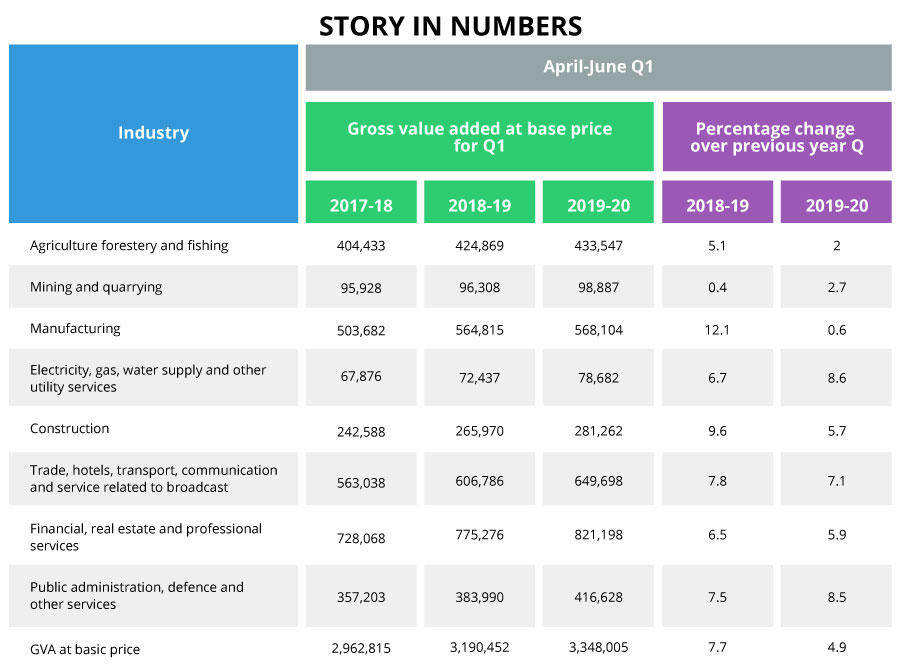
Lowest growth numbers in 6 years point to serious crisis

Whether or not the Narendra Modi government manages to make India a $5 trillion economy is in the realm of future. But, it has certainly managed to make India a 5% GDP growth country, according to the figures for the first quarter of the current financial year.
This rate of growth too is a bit of statistical legerdemain. If the growth were to be calculated according to the formula applicable till the advent of the Modi government, the figure would have been less than 3% for the first quarter of the current financial year. The effective rate is much lower than the fabled “Hindu rate of growth” — a pejorative term for India’s 3.5-5% growth till the 90s.
Also read: Why is it bad when consumers tighten their purse strings

The economy has been sliding for the past four quarters — sliding from the highs of 8.1% in the fourth quarter of 2017-18 to 5% now. The previous financial year had ended with the GDP growth at 6.8%. The growth rate for the fourth quarter of the previous year was 5.8%.
Any downturn that lasts for such a long time is bound to be because of inherent problems in the economy and is not cyclical. The data for this quarter shows the slowdown is not because of a supply-side problems but a result of the dip in private consumption — down to 3.1% from 7.1% in the previous quarter. So, it is obvious, there is a severe fall in demand for everything and people are just not buying anything.
Also read: Need new set of reforms to battle economic slowdown: Raghuram Rajan
Demand falls when people do not have money to spend, when their incomes have fallen and savings have disappeared. But, the government has still not woken up to the reality of the economy. So far, it has done nothing to boost consumption, either through tax exemptions or schemes aimed at reviving demand. Most of its recent steps have been aimed at easing liquidity and making loans more accessible, but in the absence of demand, not many entrepreneurs are willing to make fresh investments.
The reasons behind the falling demand are easy to understand. Some industry experts argue that the ongoing trade war between China and the US has hit businesses. But, many Southeast Asian countries have actually benefitted from this standoff by bringing down production costs and increasing the supply. India’s slowdown seems to be an accumulated result of two of Modi’s biggest initiatives over the past few years — demonetisation and implementation of Goods and Services Tax.
Also read: Cabinet eases norms for FDI in coal mining and single-brand retail
The decision to ban ₹500 and ₹1000 currency notes has destroyed several small and medium entrepreneurs who relied more on cash transactions. According to industry estimates, the parallel economy has shrunk by 25-30% since demonetisation. As a result, people have lost jobs, savings and sources of income. Simultaneously, the GST has made many products expensive and thus out of the reach of consumers. All this has combined to destroy demand.
Fall in growth of the manufacturing sector — 0.6% from more than 12.1% in the previous quarter — is another indication of the subdued demand. Since many industries are burdened with huge inventories, they have scaled down production.
Also read: India needs structural reforms to fire up economy, say experts
A decline in agriculture growth — 2% from 5.1% — is consistent with reports of a struggling rural economy. The decrease in consumption of FMCG goods, tractors and two-wheelers shows purchasing capacity has declined even in India’s hinterland.
Construction — an industry that is supported by more than 250 businesses — has fallen by a whopping 4%. This industry is among India’s biggest employers. The fall in its growth must have hit thousands of vendors, suppliers and workers in the industry.
The government has its task cut out. It will have to take rapid measures to put more money in the pockets of consumers, slash tax rates to make products cheaper and spend a humongous amount on infrastructure projects to revive India’s struggling economy. Whether or not the Narendra Modi government manages to make India a $5 trillion economy is in the realm of future. But, it has certainly managed to make India a 5% GDP growth country, according to the figures for the first quarter of the current financial year.

